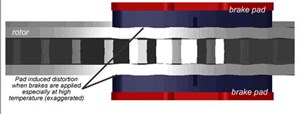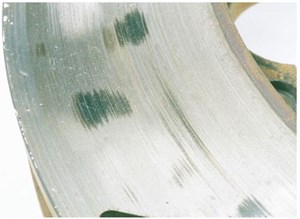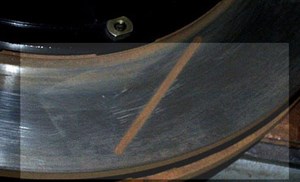The "Warped" Brake Disc and Other Myths of the Braking System
Myth # 1 – BRAKE JUDDER AND VIBRATION IS CAUSED BY DISCS THAT HAVE BEEN WARPED FROM EXCESSIVE HEAT.
The term "warped brake disc" has been in common use in motor racing for decades. When a driver reports a vibration under hard braking, inexperienced crews, after checking for (and not finding) cracks often attribute the vibration to "warped discs". They then measure the disc thickness in various places, find significant variation and the diagnosis is cast in stone.
When disc brakes for high performance cars arrived on the scene we began to hear of "warped brake discs" on road going cars, with the same analyses and diagnoses. Typically, the discs are resurfaced to cure the problem and, equally typically, after a relatively short time the roughness or vibration comes back. Brake roughness has caused a significant number of cars to be bought back by their manufacturers under the "lemon laws". This has been going on for decades now - and, like most things that we have cast in stone, the diagnoses are wrong.
With one qualifier, presuming that the hub and wheel flange are flat and in good condition and that the wheel bolts or hat mounting hardware is in good condition, installed correctly and tightened uniformly and in the correct order to the recommended torque specification, in more than 40 years of professional racing, including the Shelby/Ford GT 40s – one of the most intense brake development program in history - I have never seen a warped brake disc. I have seen lots of cracked discs, (FIGURE 1) discs that had turned into shallow cones at operating temperature because they were mounted rigidly to their attachment bells or top hats, (FIGURE 2) a few where the friction surface had collapsed in the area between straight radial interior vanes, (FIGURE 3) and an untold number of discs with pad material unevenly deposited on the friction surfaces - sometimes visible and more often not. (FIGURE 4)
In fact every case of "warped brake disc" that I have investigated, whether on a racing car or a street car, has turned out to be friction pad material transferred unevenly to the surface of the disc. This uneven deposition results in thickness variation (TV) or run-out due to hot spotting that occurred at elevated temperatures.
In order to understand what is happening here, we will briefly investigate the nature of the stopping power of the disc brake system.




THE NATURE OF BRAKING FRICTION
Friction is the mechanism that converts dynamic energy into heat. Just as there are two sorts of friction between the tire and the road surface (mechanical gripping of road surface irregularities by the elastic tire compound and transient molecular adhesion between the rubber and the road in which rubber is transferred to the road surface), so there are two very different sorts of braking friction - abrasive friction and adherent friction. Abrasive friction involves the breaking of the crystalline bonds of both the pad material and the cast iron of the disc. The breaking of these bonds generates the heat of friction. In abrasive friction, the bonds between crystals of the pad material (and, to a lesser extent, the disc material) are permanently broken. The harder material wears the softer away (hopefully the disc wears the pad). Pads that function primarily by abrasion have a high wear rate and tend to fade at high temperatures. When these pads reach their effective temperature limit, they will transfer pad material onto the disc face in a random and uneven pattern. It is this "pick up" on the disc face that both causes the thickness variation measured by the technicians and the roughness or vibration under the brakes reported by the drivers.
With adherent friction, some of the pad material diffuses across the interface between the pad and the disc and forms a very thin, uniform layer of pad material on the surface of the disc. As the friction surfaces of both disc and pad then comprise basically the same material, material can now cross the interface in both directions and the bonds break and reform. In fact, with adherent friction between pad and disc, the bonds between pad material and the deposits on the disc are transient in nature - they are continually being broken and some of them are continually reforming.
There is no such thing as pure abrasive or pure adherent friction in braking. With many contemporary pad formulas, the pad material must be abrasive enough to keep the disc surface smooth and clean. As the material can cross the interface, the layer on the disc is constantly renewed and kept uniform - again until the temperature limit of the pad has been exceeded or if the pad and the disc have not been bedded-in completely or properly. In the latter case, if a uniform layer of pad material transferred onto the disc face has not been established during bedding or break-in, spot or uncontrolled transfer of the material can occur when operating at high temperatures. The organic and semi-metallic pads of the past were more abrasive than adherent and were severely temperature limited. All of the current generation of "metallic carbon", racing pads utilize mainly adherent technology as do many of the high end street car pads and they are temperature stable over a much higher range. Unfortunately, there is no free lunch and the ultra high temperature racing pads are ineffective at the low temperatures typically experienced in street use.
Therefore - there is no such thing as an ideal "all around" brake pad. The friction material that is quiet and functions well at relatively low temperatures around town will not stop the car that is driven hard. If you attempt to drive many cars hard with the OEM pads, you will experience pad fade, friction material transfer and fluid boiling - end of discussion. The true racing pad, used under normal conditions will be noisy and will not work well at low temperatures around town.
Ideally, in order to avoid either putting up with squealing brakes that will not stop the car well around town or with pad fade on the track or coming down the mountain at speed, we should change pads before indulging in vigorous automotive exercise. No one does. The question remains, what pads should be used in high performance street cars - relatively low temperature street pads or high temperature race pads? Strangely enough, in my opinion, the answer is a high performance street pad with good low temperature characteristics. The reason is simple: If we are driving really hard and begin to run into trouble, either with pad fade or boiling fluid (or both), the condition(s) comes on gradually enough to allow us to simply modify our driving style to compensate. On the other hand, should an emergency occur when the brakes are cold, the high temperature pad is simply not going to stop the car. As an example, during the mid 1960s, those of us at Shelby American did not drive GT 350 or GT 500 Mustangs as company cars simply because they were equipped with Raybestos M-19 racing pads and none of our wives could push on the brake pedal hard enough to stop the car in normal driving.
Regardless of pad composition, if both disc and pad are not properly broken in, material transfer between the two materials can take place in a random fashion - resulting is uneven deposits and vibration under braking. Similarly, even if the brakes are properly broken, if, when they are very hot or following a single long stop from high speed, the brakes are kept applied after the vehicle comes to a complete stop it is possible to leave a telltale deposit behind that looks like the outline of a pad. This kind of deposit is called pad imprinting and looks like the pad was inked for printing like a stamp and then set on the disc face. It is possible to see the perfect outline of the pad on the disc. (FIGURE 5)
It gets worse. Cast iron is an alloy of iron and silicon in solution interspersed with particles of carbon. At elevated temperatures, inclusions of carbides begin to form in the matrix. In the case of the brake disk, any uneven deposits - standing proud of the disc surface - become hotter than the surrounding metal. Every time that the leading edge of one of the deposits rotates into contact with the pad, the local temperature increases. When this local temperature reaches around 1200 or 1300 degrees F. the cast iron under the deposit begins to transform into cementite (an iron carbide in which three atoms of iron combine with one atom of carbon). Cementite is very hard, very abrasive and is a poor heat sink. If severe use continues the system will enter a self-defeating spiral - the amount and depth of the cementite increases with increasing temperature and so does the brake roughness. Drat!
MYTH # 2 - RACING BRAKE DISCS ARE MADE FROM STEEL
MYTH # 3 - A SOFT BRAKE PEDAL IS THE RESULT OF PAD FADE
MYTH # 4 - BOILED BRAKE FLUID WILL BE SERVICABLE AFTER IT COOLS.
MYTH # 5 - NON-HYGROSCOPIC SILICON BASED BRAKE FLUIDS ARE SUITABLE FOR USE IN HIGH PERFORMANCE CARS
MYTH # 6 - THE BRAKE FLUID RESERVOIR SHOULD BE TOPPED UP DURING ROUTINE SERVICE
Please visit the StopTech website for the remainder of this detailed article:
http://www.stoptech.com/tech_info/wp_warped_brakedisk.shtml

